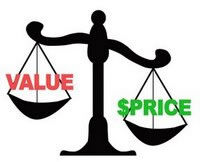Customer Value – The Front Line Perspective
 I went down the street to the 24-hour grocery. When I got there, the guy was locking the front door. I said, “Hey, the sign says you’re open 24 hours.” He said, “Yes, but not in a row.” –Steven Wright
I went down the street to the 24-hour grocery. When I got there, the guy was locking the front door. I said, “Hey, the sign says you’re open 24 hours.” He said, “Yes, but not in a row.” –Steven Wright
 One of the topics that has been top of mind in management discussions and planning sessions of late is the difference between customers who are price focused and customers who are value focused. Not a bad thing to discuss in a time of skinnier margins and challenged fee income. The premise is that sales and relationship management efforts should focus on customers and prospects that are less price-sensitive because they see value in some aspect of product, service, knowledge, or other delivery that you provide.
One of the topics that has been top of mind in management discussions and planning sessions of late is the difference between customers who are price focused and customers who are value focused. Not a bad thing to discuss in a time of skinnier margins and challenged fee income. The premise is that sales and relationship management efforts should focus on customers and prospects that are less price-sensitive because they see value in some aspect of product, service, knowledge, or other delivery that you provide.
Gonzo tribemembers, this idea is like many others related to sales and service that have been put forth in recent years. Conceptually, you can’t argue with it. Who wouldn’t want customers who pay more because they value something in the relationship?
However, as is true for many ideas that are killer in theory, the execution of the concept with specific goals and focus and the right metrics is just a wee bit harder. You have to define it well, and you have to measure success equally well. Furthermore, it relies heavily on the execution ability of your front-line employees (branch, lending, call center, Internet support et al.) who have to deliver the value proposition.
So, this got me to thinking. What does the front line think customers value? What do they think customers are willing to pay for? How do you make a value proposition work?
As it happens, at Cornerstone we spend a lot of time with front-line employees, so over the last few months I have been asking them about this. It makes for some good listening, and their perspective carries some weight you don’t want to ignore. After all, aren’t they the ones who see customers every day?
Here’s what we heard your front-line folks say about the whole value issue:
-
 It won’t happen without knowledgeable front-line employees. There is nothing customers value more than an employee who is clearly knowledgeable and confident when talking about a loan, an investment, a payment or any other part of banking. If the customer can trust that the person in front of them knows their stuff, they will come back again and again. And this isn’t just product features. It’s an employee who understands the home-buying process, or what happens when somebody leaves a job with a retirement payout, or what happens when an international wire is sent. Knowledge is the best hard currency an employee can have. (Translation –
we need more productndustry training.)
It won’t happen without knowledgeable front-line employees. There is nothing customers value more than an employee who is clearly knowledgeable and confident when talking about a loan, an investment, a payment or any other part of banking. If the customer can trust that the person in front of them knows their stuff, they will come back again and again. And this isn’t just product features. It’s an employee who understands the home-buying process, or what happens when somebody leaves a job with a retirement payout, or what happens when an international wire is sent. Knowledge is the best hard currency an employee can have. (Translation –
we need more productndustry training.)
-
It has to have a tone of advocacy. At the end of the day, customers want to think that although there are prices and rules that can’t be ignored, the employee in front of them is trying to figure out the best deal for them. Sometimes, it might involve counseling on how to reduce fees or interest paid. Sometimes, it might mean that the customer should delay an investment decision. In a funny way, the customer wants the employee to say, “So, how can we collude together and beat the house?” As long as you have accounts and pricing right, that’s a pretty good question. (Translation: we’ll do what’s right for both sides.)
-
 Value is demonstrated at the point of contact based on specific encounters, not sold in advance by marketing. It’s amazing to hear branch or loan employees talk about one problem or question that will stick in a customer’s mind forever and influence how they value their bank. It could be an extra step taken to get a business customer funds quickly. Or an expedited loan. Or the disrespectful refusal to cash a check for Weird Uncle Herman, even if he did slobber a bit on the teller counter. Whatever the opportunity, the line understands that they need to patiently wait for the opportunity to show why they should be valued, then pounce on it. Sort of a wait and watch game. (Translation:
give us the latitude and time to execute the value proposition. We know we are accountable for getting it right.)
Value is demonstrated at the point of contact based on specific encounters, not sold in advance by marketing. It’s amazing to hear branch or loan employees talk about one problem or question that will stick in a customer’s mind forever and influence how they value their bank. It could be an extra step taken to get a business customer funds quickly. Or an expedited loan. Or the disrespectful refusal to cash a check for Weird Uncle Herman, even if he did slobber a bit on the teller counter. Whatever the opportunity, the line understands that they need to patiently wait for the opportunity to show why they should be valued, then pounce on it. Sort of a wait and watch game. (Translation:
give us the latitude and time to execute the value proposition. We know we are accountable for getting it right.)
-
Customers value (and love) empowered employees. Question: What are the five words front line employees hate the most? Answer: “I have to get approval.” A huge component of customer value is the notion that they can trust the bank to do what it says it will do. The thing the line points out is that they don’t want to trust the bank as an entity, they want to trust the person they talk to. One of the big frustrations of front line employees is when they know they should be able to make a promise but instead have to say that they need to get permission. It makes the customer value the employee less. If you ever want to experience a best-practice empowered employee, give a call to the USAA call center. You’ll see what I mean.
-
 Customers value recognition of the longevity of their relationship as much as the cumulative amount. Let’s say you have two customers. The first is a profitable customer who is letting a CD automatically renew for the fifth time. The second is an off-the-street customer with new money who just read one of your ads. Who is likely to get the better rate?
Customers value recognition of the longevity of their relationship as much as the cumulative amount. Let’s say you have two customers. The first is a profitable customer who is letting a CD automatically renew for the fifth time. The second is an off-the-street customer with new money who just read one of your ads. Who is likely to get the better rate?
One thing branches point out is that they sometimes do not get to reward and recognize the customer who has been there for many years. “New money” gets the focus instead. Relationship pricing is a very valid concept – branches just want to point out that maybe longevity should be part of the criteria in addition to size of relationship.
 They value contact and interaction, but only on their terms. Customers are a little bit like teenage daughters. When they need you, you had better be there immediately and stay there 100% until they are happy. When they don’t need you, you’re too close if you’re in the next state.
They value contact and interaction, but only on their terms. Customers are a little bit like teenage daughters. When they need you, you had better be there immediately and stay there 100% until they are happy. When they don’t need you, you’re too close if you’re in the next state.
One thing electronic support groups point out is that the thing an Internet customer most values about their bank is that they never, ever have to talk to them at all about anything. The “I’ll call or text if I ever need you” message gives sales managers hives, but a growing number of customers, particularly young ’uns, feel that way. (Makes sense to me. Do you really want to talk to your cell phone company, or your plumber?)Translation to both of these points – can we have some input on the campaign/outbound call programs? Please?
If this perspective and these messages are obvious and you already base your value proposition on them, good. But maybe we all need to take a moment, sit down with the branch, loan, call center and other customer delivery folks that will make the value proposition work or not, and make sure their point of view gets its due. Go out and visit with them on this topic. They are a pretty smart bunch of people.
-tr
IS YOUR FRONT LINE STAFF OPTIMIZED?
Are you developing a culture that fosters training, empowerment, and a strong customer service ethic?
Do you have the right number of people, with the right skills, working appropriate hours to effectively meet customer needs?
Cornerstone Advisors can show you how top performers at best practice organizations are getting it done.
Contact us to talk about building a first impression that really says, “We Care!” and keeps customers coming back.